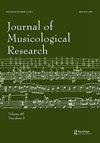Musical Topoi in Brahms’s 7 Fantasien, Op. 116
IF 0.4
2区 艺术学
0 MUSIC
引用次数: 0
Abstract
ABSTRACT A fair amount of literature has been published on the use of musical topics in the works of eighteenth-century composers, with the writings of Leonard Ratner and Wendy Allanbrook among the most influential. Allanbrook, Ratner, and their disciples have shown how studying representations of topics in opera might allow for the recognition of those same musical characteristics when they appear in instrumental music. Although for these scholars the use of topics was an eighteenth-century practice, it is also useful to consider their use in nineteenth-century repertoire. Ratner’s method can be used to create a guideline for the general musical topoi that Johannes Brahms uses in his late piano works through the examination of his other piano pieces, chamber music works, and songs. The comparison of Brahms’ written tempo markings and the examination of textural elements such as rhythmic patterns, figurations, and key areas help support the identification of certain topical characteristics. Brahms’ songs in particular offer instructive information on common textural topoi, where the text helps underline the given mood of a passage. The compilation of a list of musical topoi used by Brahms, one that reflects both the given period’s and the composer’s personal musical choices, furthers the understanding of Brahms’ musical language and allows for more well-informed interpretations of his works.116号歌剧魅影
关于18世纪作曲家在作品中使用音乐主题的研究已经发表了相当多的文献,其中最有影响力的是伦纳德·拉特纳和温迪·阿伦布鲁克的作品。Allanbrook、Ratner和他们的弟子们已经证明,研究歌剧主题的表征可能会让我们在器乐中发现同样的音乐特征。虽然对这些学者来说,主题的使用是18世纪的惯例,但考虑它们在19世纪的曲目中的使用也是有用的。通过考察勃拉姆斯的其他钢琴作品、室内乐作品和歌曲,拉特纳的方法可以用来为勃拉姆斯在其晚期钢琴作品中使用的一般音乐拓扑创建一个指导方针。勃拉姆斯的书面节奏标记的比较和对节奏模式、图形和关键区域等织体元素的检查有助于识别某些主题特征。勃拉姆斯的歌曲特别提供了关于常见的织体拓扑的指导性信息,其中文本有助于强调段落的给定情绪。勃拉姆斯所使用的音乐主题列表的汇编,反映了给定时期和作曲家个人的音乐选择,进一步了解勃拉姆斯的音乐语言,并允许对他的作品有更充分的了解。
本文章由计算机程序翻译,如有差异,请以英文原文为准。
求助全文
约1分钟内获得全文
求助全文
来源期刊
CiteScore
0.30
自引率
0.00%
发文量
17
期刊介绍:
The Journal of Musicological Research publishes original articles on all aspects of the discipline of music: historical musicology, style and repertory studies, music theory, ethnomusicology, music education, organology, and interdisciplinary studies. Because contemporary music scholarship addresses critical and analytical issues from a multiplicity of viewpoints, the Journal of Musicological Research seeks to present studies from all perspectives, using the full spectrum of methodologies. This variety makes the Journal a place where scholarly approaches can coexist, in all their harmony and occasional discord, and one that is not allied with any particular school or viewpoint.

 求助内容:
求助内容: 应助结果提醒方式:
应助结果提醒方式:


